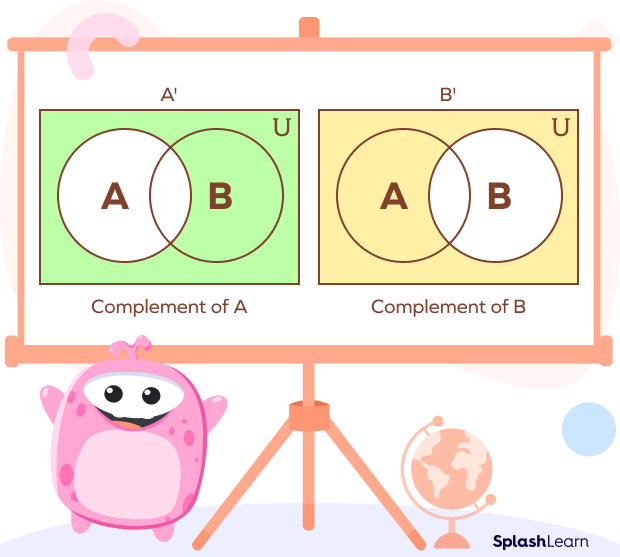What Is the Complement of a Set?
In set theory, the complement of a set is the set of all elements that belong to the universal set but not to the original set.
The complement of a set A is denoted by A’ or Ac.
Example:
Universal set $= U =$ Set of all integers
$U = \left\{…, -\;3,\;-\;2,\;-\;1,\; 0,\; 1,\; 2,\; 3,…\right\}$
Let A be the set of even integers.
$A = \left\{…,\;-\;2,\; 0,\; 2,\; 4,…\right\}$
Here, the complement of A is the set of odd integers.
Complement of set $A = A’ = \left\{…,\;-\;3,\; -\;1,\; 1,\; 3,…\right\}$
Recommended Games
Definition of Complement of a Set
The difference between the universal set U and set A is called the complement of that set A.
If U is a universal set and A be any subset of U, then the complement of A is the set of all members of the universal set U, which are not the elements of A.
Mathematically, the complement of a set A with respect to a universal set U is defined as
$A’ = \left\{x \in U : x \in A\right\}$
The complement of A is the set of all elements x in U that are not in A.
Recommended Worksheets
Complement of a Set Symbol
The complement of the set A is denoted as A’ or Ac . The notation of the complement of a set uses an apostrophe (‘) or a superscript c after the name of the set.
Also, as we know that the complement of A is the difference between Universal set and the set A, we can write
$A’ = U\;-\;A$
Complement of a Set: Venn Diagram
A universal set is typically represented using a rectangular box. Subsets of the universal set are generally represented by a circle. The complement of a set is the region of the universal set outside the set A.
The Venn diagram of the complement of set A is shown below. Here, the shaded portion in yellow shows the complement of set A.

If we have two sets that intersect each other, the complements of sets can be represented as follows:

Cardinality of the Complement of a Set
Let the cardinality of the set A be n(A), the cardinality of the universal set U be n(U), then the cardinality of the complement of A, which is represented by n(A’) or |A’| is given by
$n(A’) = n(U) \;-\; n(A)$
$|A’| = |U| \;-\; |A|$
Properties of the Complement of a Set
Let’s discuss the properties of the complement of a set.
Complement Laws
- The union of a set A and its complement A’ is equal to the universal set U.
$A \cup A’ = U$
- The intersection of set A and A’ is the empty set
$A \cap A’ = ∅$
Law of Double Complementation
The complement of the complement of a set A is equal to A itself.
$(A’)’ = A$
Law of Empty Set and Universal Set
An empty set or null set (∅) is the complement of the universal set. The universal set is the complement of the empty set.
$∅’ = U$
$U’ = ∅$
De Morgan’s Laws
De Morgan’s laws are a set of two fundamental laws in a set theory that relate the complement of set operations. They are named after the mathematician Augustus De Morgan, a British mathematician .
- The complement of the union of two sets A and B is equal to the intersection of their complements.
$(A \cup B)’ = A’ \cap B’$
- The complement of the intersection of two sets A and B is equal to the union of their complements.
$(A \cap B)’ = A’ \cup B’$
How to Find the Complement of a Set
To find the complement of a set, follow the steps mentioned below:
Step 1: Write the elements of the universal set. Write down all the elements in the original set.
Step 2: Find the difference between U and A. In other words, identify all the elements in the Universal set that do not belong to the original set.
Step 3: The elements identified in step 3 form the complement of the set.
Example: $U = \left\{1, 2, 3, 4, 5, 6, 7, 8, 9, 10\right\}$
$A = \left\{1, 3, 5, 7, 9\right\}$
$A’ = U\;-\;A = \left\{ 2, 4, 6, 8, 10\right\}$
Facts about the Complement of a Set
- The complement of an empty set is the universal set.
- The complement of a universal set is the empty set.
- The set and its complement are disjoint sets.
- The complement of a set is unique.
- The cardinality of a complement of a set is the difference between the cardinality of the universal set and the cardinality of the given set.
Conclusion
In this article, we have discussed the complement of a set, the notation, the Venn diagram, the properties of the complement of a set, and the method to find the complement. Let’s solve a few examples and practice problems.
Solved Examples on the Complement of a Set
- Let set $B = \left\{\text{Monday, Tuesday, Wednesday, Friday}\right\}$. Find the complement of B.
Solution:
$B = \left\{\text{Monday, Tuesday, Wednesday, Friday}\right\}$.
Here, $U =$ Set of all days in a week
$U = \left\{\text{Monday, Tuesday, Wednesday, Thursday, Friday, Saturday, Sunday}\right\}$
Let’s find the complement of B.
$B’ = U\;-\;B$
$B’ = \left\{x | x \text{is a day of the week and x is not in B}\right\}$
$B’ = \left\{\text{Thursday, Saturday, Sunday}\right\}$.
- Let $Y = \left\{x | x \text{is a positive even integer}\right\}$. Find the complement of Y, if U is the set of positive integers.
Solution:
$Y = \left\{x | x \text{is a positive even integer}\right\}$
Here, U is the set of positive integers.
Therefore, $Y’ = \left\{x | x \text{is a positive integer and x is odd}\right\}$
$Y’ = \left\{1,\; 3,\; 5,\; 7,\; 9, …\right\}$.
- If $U = \left\{1,\; 2,\; 3,\; 4,\; 5,\; 6,\; 7,\; 8,\; 9,\; 10\right\}$ and $A = \left\{2,\; 3,\; 5,\; 7\right\}$. Find the complement of A.
Solution:
$U = \left\{1,\; 2,\; 3,\; 4,\; 5,\; 6,\; 7,\; 8,\; 9,\; 10\right\}$
$A = \left\{2,\; 3,\; 5,\; 7\right\}$
$\therefore A’ = U \;-\; A = \left\{1,\; 4,\; 6,\; 8,\; 9,\; 10\right\}$
- If $B = \left\{x: x \text{is a vowel in English alphabets}\right\}$, then find B’.
Solution:
$B = \left\{ x : x \text{is a vowel in English alphabets.}\right\}$
$B = \left\{a,\; e,\; i,\; o,\; u\right\}$
$B’ = \left\{\text{b, c, d, f, g, h, j, k, l, m, n, p, q, r, s, t, v, w, x, y, z}\right\}$
$B’= \left\{x: x \text{is not a vowel in English alphabets.}\right\}$
$B’ = \left\{x: x \text{is a consonant in English alphabets.}\right\}$
- Let $U = \left\{1,\; 2,\; 3,\; 4,\; 5,\; 6,\; 7,\; 8,\; 9\right\}$. If $A = \left\{1,\; 2,\; 3\right\}$ and $B = \left\{4,\; 5,\; 6\right\}$ and $C = \left\{7,\; 8,\; 9\right\}$, then find (A U B U C)’.
Solution:
$A = \left\{1,\; 2,\; 3\right\}$ and $B = \left\{4,\; 5,\; 6\right\}$ and $C = \left\{7,\; 8,\; 9\right\}$
$A U B U C = \left\{1,\; 2,\; 3,\; 4,\; 5,\; 6,\; 7,\; 8,\; 9\right\} = U$
$\therefore (A U B U C)’ = U’ = ∅$
- If $U = {1,\; 2,\; 3,\; 4,\; 5}$ and $C = \left\{1,\; 3,\; 5\right\}$ then find (C’)’?
Solution:
$(C’)’ = C$
$U = \left\{1,\; 2,\; 3,\; 4,\; 5\right\}$ and $C = \left\{1,\; 3,\; 5\right\}$
$C’ = \left\{2,\; 4\right\}$
Again taking the complement of C’, we get
$\therefore (C’)’ = \left\{2,\; 4\right\}’ = \left\{1,\;3,\;5\right\} = C$
Practice Problems on Complement of a Set
Complement of a Set - Definition, Properties, Examples, Facts, FAQs
$A \cup A' =$
$A \cup A' = U$
If $U = \left\{a,\; b,\; c,\; d,\; e,\; f\right\}$ and $B = \left\{a,\; c,\; e\right\}$, what is the complement of B?
The complement of B consists of all elements in the universal set that are not in B. $B’ = \left\{b, d, f\right\}$.
$U’ =$
$U’ = ∅$
If $U = \left\{a,\; b\right\}$ and the set $D = \left\{b\right\}$, what is the complement of D?
$U = \left\{a,\; b\right\}$
$D = \left\{b\right\}$
$D’ = U\;-\;D = \left\{a\right\}$
$(A \cup B)' =$
By De Morgan’s law, $(A \cup B)'= A' \cap B'$
Frequently Asked Questions about the Complement of a Set
What is the meaning of a complement set?
The meaning of a complement set is the set of all elements in the universal set that are not in the given set.
What is the notation for the complement of a set?
The symbol used to denote the complement of a set is usually an apostrophe (‘) or a superscript c, placed after the set symbol. For example, if A is a set, then its complement can be denoted by A’ or Ac.
What is the formula for the complement of a set?
The formula for the complement of a set A with respect to a universal set U is given byA’ $= U\;-\;A = \left\{x \in U | x \in A\right\}$
What is the difference between a set and its complement?
A set and its complement have no element in common.Thus, $A \;-\; A’ = A$
What is the complement of the empty set?
The complement of the empty set is the universal set.

































